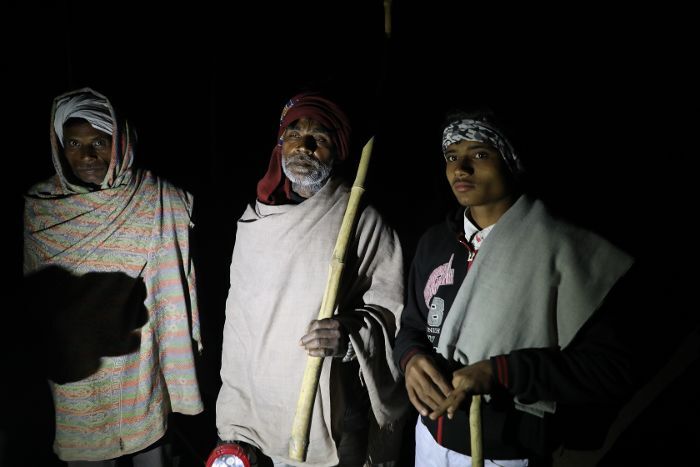Lucknow/ Barabanki/ Sitapur
It was the first night of January. It was pitch dark. The fog was so dense that a man standing at 10 feet could not be seen. It was about 9 pm and the temperature was already 10°c. Although it was so cold that one could see one’s own breath, Rohit Kumar of Gundhi village in Uttar Pradesh stood guarding his fields.
The first stop of the Gaon Connection team with farmers was Gundhipur village in Barabanki district of Uttar Pradesh. On January 1, the team took off from Lucknow at about 6 pm. On the way, the farmers could frequently be seen in their fields equipped with sticks and torches. In many places, the farmers were found sitting by the roadside, huddled in groups around fire and trying to protect themselves from the cold. These farmers are, however, troubled more due to stray animals whose flocks might ruin almost ready to be harvested crops in no time.
At 9 pm, Rohit was almost shivering with his companions on the road in Gundhipur village which is on Belhara-Cheda Road, about 70 kms from Lucknow in Barabanki district.
Rohit said: “At about 8-9 in the night, I eat and come to the fields and stay here till 2-3 in the morning. When I reach home, my father leaves for the fields. Thus, we guard our fields round the clock. There are so many stray bulls that they come in a hoard of 20-25 grazing through half of the crop and trampling upon the remaining half.”
Sushil standing next to Rohit, with his face covered by a shawl, is very upset too. His two bighas of lentils have just been rummaged by the strays. Sushil said: “Every single day, I had come to guard the fields. Two days ago, when I’d been to Lucknow to attend to some pressing work, the crop got damaged. Now a bigha of wheat is left, so I come to protect it.”
When Rohit and Sushil were talking to the Gaon Connection team, the torch was being lit in distant fields and the noise of the people running was perceptible. These farmers were engaged in the removal of the crop-grazing strays.
From Barabanki in Uttar Pradesh, and Bundelkhand’s Lalitpur and Siddharthnagar to Hathras, farmers are suffering acutely from strays’ nuisance. These strays are cattle ruling the headlines in the country for the last several years.
According to the Uttar Pradesh animal husbandry department, there are about 11 lakh stray cattle in the state. But as per the villagers, in this state with more than 59,000 gram panchayats, every gram panchayat will have about 100 such animals. In Uttar Pradesh, farmers harassed by these strays in Aligarh and Hathras gathered and locked up these animals in government schools and hospitals. Angry farmers have even threatened of an agitation.
How the farmers pass their nights in the cold to save their crops, to understand their difficulty and pain, when Gaon Connection set out to the fields at night, it came across numerous farmers like Rohit.
As the night advanced so did the cold and fog. Further on the way to Gundhipur, the team reached Ranjitpur village. At that time, at midnight, about a dozen cows and bulls appeared from the jungle and entered the village, but the elderly stationed in his thatch on the village intersection drove them away. He might not have dared to venture out in the cold.
From Ranjitpur, when the team moved a little further from Cheda village, some people were winding barbed wire upon the main route. It was Arun Mishra and his family from Sonhara village and they were picking up the wire. On asking the reason, Mishra said: “At about 10 in the night, I was going to the village by motorcycle, when I saw some thieves cutting the wires. I tried confronting them, but they ran away. So, I have come with the whole family to take away the wire.”
He added: “The problem has increased greatly in the past 3-4 years. There were great expectations from the BJP government but it too did nothing to save the farmers from these cows.”
Talking to Arun and the people standing around him, it soon was about 1 AM. The fog had become too dense to drive on the road. The cattle were also not visible around the road. Naseem from Ranjitpur village explained: “Our village has a large pond, the farmers herd these animals there preventing further damage due to them. Now the night is high, so these animals will have gone near orchards or trees.”
The second day began at Gonda Deoria village of Rampur Mathura block in Sitapur district. Many farmers were found returning from the fields in blankets and towing beddings. In many places, nilgai was also found in sugarcane fields, but their number was quite low.
Surendra Bahadur Singh runs Shri Radha Goshala here. Talking about the plight of farmers, he said: “The biggest problem is posed by the bull calves because they are not of any use. They are not used in the fields and with the cows giving little milk, the farmers unwilling to take care let them loose. Now they graze the crops. When the farmers drive them away, they run off to other fields. Where the wires are fitted, they get injured. The plight of both farmers and cattle is pitiable.” The village has several such cows and cattle that have been wounded severely due to barbed wire.
Then, from Deen Dayal Awasthi and Ramu to Ramdhan, everyone shared one’s own problem. They had hoped that speaking in front of the camera might bring a solution to their problems. But Rambahadur Singh of Gonda Deoria village, who is a teacher by profession, explained the work of journalists to the people. He said: “Unless the cow is made beneficial to the farmers, the farmer will not be able to rear them. At present, he considers the cow less a mother and more a headache and even the greatest enemy. What else can he do?”
The fog began to subside with the rise in sunlight. Moving from Gonda Deoria to Rampur Mathura town in Sitapur district, some farmers were seen removing the stray bulls from a mustard field. At the same place, while taking the bulls’ visuals, some farmers and the Gaon Connection team narrowly escaped the bulls galloping across the fields surrounded by barbed wire.
Gurvinder Singh, who came from Punjab and settled in the village of Abhinapur, said: “The bull do not just damage the crop, they also attack the farmers when they get a chance. My brother and father have also been hurt by them.” Govind, standing next to Gurvinder informed: “Last year, I was in the fields when I was attacked by a bull. My cries brought villagers to my rescue and so I was saved.” We came across everyone attacked by the bulls from strapping youths to frail and old. An elderly farmer from Garhchappa village narrowly avoided being killed in such an attack.”
According to newspaper reports, farmer Rajpal, 55, of Manrauli village of Jewar in Gautam Budh Nagar was attacked by a bull this year while irrigating the field, killing him. On farmers’ uproar, the issue was settled after an assurance of five years compensation, but then there is no commotion or government help for every farmer injured by the strays.
It was for the first time during the journey when a farmer ploughing the bullocks in a field was found. Shafikun of Nimba village was accompanying her father in the field with her two sisters. Sorting out the roots of mentha, Shafikunn spoke even before her father, “How would the loan be repaid if the crop has been rummaged?”
Many farmers asked the same question. There wasn’t any answer, so it could not be given. It was about 10.30 PM when our team reached Garhchappa Gram Panchayat. About a dozen people were warming themselves by the fire at the home of pradhan Mukund Tiwari. Many of these people narrated the agony of passing nights in the open and the terror of the stray animals in the winter. Many villagers showed how they were protecting their own animals’ fodder from strays. Villagers told about more than four such places within the gram panchayats where 100 such strays could be witnessed together.
In the same gram panchayat, about 100 cows and bulls were sitting near a sugarcane crusher outside the Bahadur Bazaar. Seeing the camera, Ramtirath, son Santu of Durjanpur village, said: “Sir, the whole five bigha wheat has been ravaged by the cows when I just missed yesterday despite keeping vigil the whole other time.” The field of Ramtirath was not yet irrigated and got damaged already.
How much these animals are harming the farmers, can easily be understood by the words of Mukund Tiwari, the pradhan and a major farmer of Garhchapa panchayat. He informed: “I used to sell Rs 5-7 lakh worth of maize in a year but this time there is not even a yield of 10-15 quintals (Rs 1,700 per quintal). Same is for sugarcane. It has become very difficult for the farmers to save their crops. If steps are not taken in this direction soon enough, the farmer will not be able to cultivate anymore.”
Last year, Mukund Tiwari had put up a barbed wire costing Rs 1 lakh surrounding his fields, but it has been broken at lot of places. He said: “When animals do not get fodder, they wander for two or three days. Then they are unstoppable — whether one puts up a wire or fence. They also have to survive. They also get injured many times. We worship the cow and don’t want them to be injured by barbed wire, but we are helpless as we need to save our crops too.”
At many places during the visit farmers had suggested building Goshalas at gram panchayat level besides imposing a ban upon release of strays. At the same time, those who leave the holiday animals are also banned.
Mukund Tiwari said: “This situation has turned very grave. The government should immediately form a committee to open goshalas along the fallow land, sealing land or rivers at the gram panchayat level and link it with MGNREGA. Many people will also contribute to it. I can also give Rs 20-25,000 to the government every year for any such goshala, the money will be saved from the current expense in crop protection.”
In view of the problem of stray cattle and the pathetic condition of cows, the Yogi Adityanath government has instructed to build gaushalas across the state. According to news, all the stray cows have to be transported to these goshalas by January 10. Besides, for the breed improvement of cattle, only heifer-producing semen has also been sourced from abroad.
Reporting assistants: Diti Bajpayee, Abhishek Verma, Ranvijay Singh, Virendra Singh.
Note: The story was originally published in January 2019.















